|
Printables |
PowerPoints |
Online exercises |
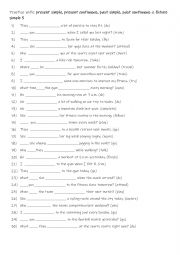
|
A1-A2 Practise with present simple, present continuous, past simple, past continuous & future simple 5
Students need to use present simple, present continuous, past simple, past continuous, and future simple to communicate effectively and express time-related ideas clearly in English. The present simple is used for routines, habits, and facts, while the present continuous describes ongoing or temporary actions. The past simple narrates completed eve...
Level: elementary
Age: 7-100
Type:
Downloads: 116
|
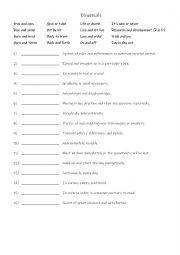
|
Binomials - common pairs of words 1b
Students read the definitions and match them with the correct pair of words.These pairs are often used for their rhythmic and memorable qualities, making the language more engaging and easier to remember.In English grammar, binomials are expressions where two words are joined by a conjunction (usually "and" or "or") to form a fixed phrase. These wo...
Level: intermediate
Age: 12-100
Type: worksheet
Downloads: 117
|
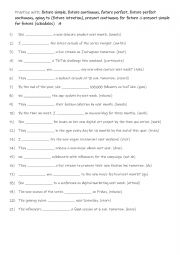
|
B1-B2 Future Simple, Future Continuous, Future Perfect, Future Perfect Continuous, Going to (Future Intention), Present Continuous for Future, Present Simple for Future (Schedules) � 4
First, students need to familiarise themselves with the tenses and check their meaning and use. Then they read the sentences to see which tense is needed to complete the sentence using the given verb in (). Each tense is used 3 times! Answers on page 2.
Level: intermediate
Age: 10-100
Type:
Downloads: 110
|
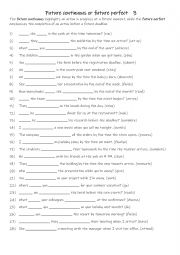
|
A2+-B1 Future continuous or future perfect 3
First, students need to familiarise themselves with the 2 tenses and their use. Then they read the sentences to work out which tense is needed to complete the gap-fill using the infinitive in (). Each tense is used 12 times! Answers on page 2
Level: intermediate
Age: 9-100
Type:
Downloads: 121
|
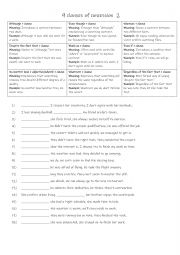
|
9 clauses of concession 2
First, students need to familiarise themselves with the 9 clauses and their meanings. Then they read the sentences to see which one is required to complete the gap-fill. Each clause is used 2 times! Answers on page 2.
Level: intermediate
Age: 11-100
Type:
Downloads: 112
|
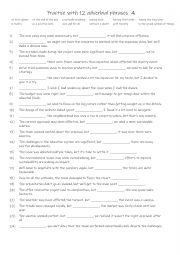
|
B1-C1 Practice with 12 adverbial phrases 4
Learning adverbial phrases are essential for effective and nuanced communication. These phrases allow students to organise ideas, express perspectives, and add emphasis or transitions in both spoken and written English. For instance, they can introduce initial impressions (at first glance), summarise a conclusion (at the end of the day), shift focu...
Level: intermediate
Age: 12-100
Type:
Downloads: 108
|
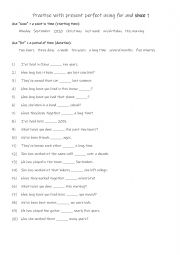
|
A1+-A2 Practise with present perfect using for and since 1
Students read the sentences and complete the sentences with the required word. Answers on page 2.
Level: elementary
Age: 8-100
Type:
Downloads: 116
|
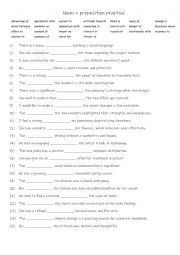
|
B1-B2 Noun + preposition practise Part 3
Understanding how to pair nouns with the correct prepositions helps convey ideas more clearly, reducing ambiguity. Many phrases in English are idiomatic; knowing these combinations allows students to speak and write more naturally, as native speakers do. Many of these nouns are relevant in everyday conversations and discussions, making this knowled...
Level: intermediate
Age: 9-100
Type:
Downloads: 102
|
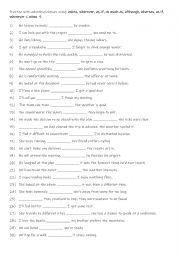
|
Practise with adverbial clauses using: unless, wherever, as, if, as much as, although, whereas, as if, whenever & when 5
Learning adverbial clauses using words like unless, wherever, as, if, as much as, although, whereas, as if, whenever and when helps students express complex relationships between ideas, such as condition, time, contrast, and manner. First, students need to familiarise themselves with the 10 adverbial clauses and their use. Then they read the senten...
Level: intermediate
Age: 10-100
Type:
Downloads: 100
|
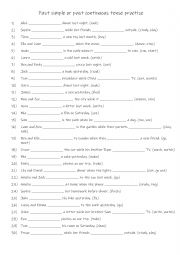
|
A1 Past simple or past continuous tense practise
Students read the sentences, then using key words to decide which tense is required to complete the gap-fill with the correct tense. Answers on page 2
Level: elementary
Age: 8-100
Type:
Downloads: 116
|
|
|
|
|












